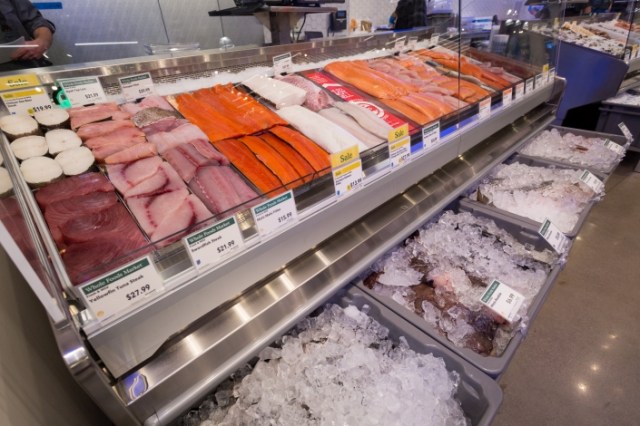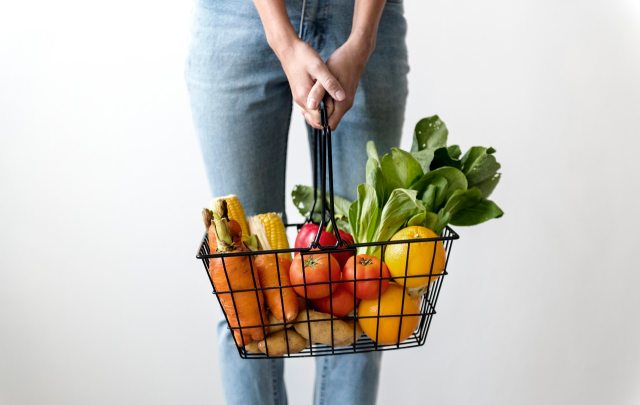When it comes to feeding our families, parents know that despite our best intentions, sometimes all we can handle is what is quick and easy. But we also know that healthy food choices now set our kids up for better choices as they grow up. So what’s a busy parent to do?
We asked some nutritional experts for advice on what to buy at the grocery store to set ourselves up for success, whether prepared foods, frozen veggies, or fresh. So even when you’ve got to bust out the mac and cheese once in a while, take their tips below, and you’ll be on the right track for a happy, healthy, well-fed family.
What to Buy

Fresh Seafood
Registered dietician and Fresh Thyme Market's resident industry and retail expert Meghan Sedivy recommends parents make seafood a main source of protein twice a week if possible. “In addition to being a great meatless alternative, fatty fish such as salmon, tuna, sardines, trout, or oysters are rich in Omega-3 fatty acids that promote brain and heart health."
If you're not out there with a rod and a reel yourself, the frozen fish you find at the grocery store is usually flash-frozen for optimal taste and freshness, which makes it easy to have it on hand for a quick dinner. Sedivy reminds us that fatty fish is also, "a great source of vitamin D, the sunshine vitamin, which aids in calcium absorption, immune function, and protecting bone, muscle, and heart health.”
Whole Foods
Have you ever heard the term “shopping the edges?” It means focusing on the exterior aisles of the grocery store—where the whole foods reside (all the processed food is in the middle). Renowned chef Gerard Viverito, aka “The Sustainable Chef,” stresses the importance of eating whole foods because that’s where you’ll get a nutritional bang for your buck. He says,” Emphasize food quality over quantity by focusing on whole, unprocessed foods that are nutrient-dense foods, high in fiber and low in net carbs-but are still packed with other nutrients.”
Also, according to Nicolette M. Pace, MS, RDN, CDE, CBC, CDN, CFCS, and FAND, you should be paying attention to the labels. “Don't be fooled by packaged items that are marketed as ‘made with fresh fruit’ or ‘contains a full serving of vegetables.’ Single-ingredient foods like an apple or broccoli do not need labels they are whole foods." Instead, Pace recommends that you cut your selections to those with five or fewer ingredients. "More than likely, a paragraph of ingredients will contain additives, preservatives or flavor enhancers which if routinely eaten can have a negative impact on a child's health.”
Plant-Based Snacks
Often, the snack foods our kids want for lunch or after school are just empty calories. Consider swapping some of them out with plant-based snacks. Kids will still feel like they're eating snacks, but they'll fill up on fiber and protein. Jill Castle, MS, RDN, is a huge believer in plant-based proteins for kids. “For plant-based snack ideas, try edamame in the shell or black bean dip with whole-grain crackers,” she says. Or, if they’re dying to have a favorite like mac and cheese, a plant-based version, like Banza, a high-protien, chickpea-based pasta, is a good substitution. “Not only does it deliver a plant-based source of protein, but it’s also a significant source of calcium and iron,” says Castle.

Fresh (and, If Possible, Local) Produce
When it comes to healthy food, fresh is best. The best way to eat fresh produce is to try to eat seasonally and locally. If you can’t swing that, stick with what’s available or frozen veggies. It’s also important to try to “eat the rainbow,” Pace says. “Start with a list of different fruits and vegetables that are five different colors in a rich rainbow of healthy nutrition for a child's mental and physical growth. A colorful plate of food is not only appealing to kids, but the plant pigments in red, orange/yellow, green, purple, and even white are plant chemicals, which are super-smart superfoods that help keep kids healthy and develop well.”
Sedivy agrees with this concept. “I always recommend picking up fresh, in-season produce when grocery shopping. Not only do fruits and vegetables add a pop of color to your plate, but they add flavor, and texture and increase your nutrient intake. Aim for at least three different colored fruit or veggie options like blueberries, tomatoes, green beans, or Brussels sprouts to ensure that you are consuming a variety of nutrients.”
Healthy Fats
Fat can be an excellent source of nutrition; it just depends on what type you're eating, and yes, there’s a difference. Fats from things like avocados, nuts, seeds, and fish are all filled with healthy-boosting qualities. Chef Viverito is a big fan. His list of healthy fat sources includes grass-fed butter, ghee, avocados, coconut oil, MCT oil, olive oil, sesame oil, walnut oil and Malaysian certified sustainable palm oil. He mentions palm oil in particular. “Malaysian palm oil has scientifically proven benefits for the heart, brain and liver. It is loaded with carotenoids, much more than carrots and tomatoes. It’s also much better for cooking and grilling, as it holds up to high heat and has a neutral flavor.”
Pantry Staples
It’s important to have a few basic ingredients on hand at all times, so you can make a homemade meal instead of deferring to pre-packaged meals, so be sure to always have a running list before you hit the grocery store. If you're wondering what you can make with these few ingredients, check out our roundup of pantry meals.
What Not to Buy

Sugary Drinks
We’ve known about this one for a while, but sometimes it can be tempting to let the kids have that sugar-free energy drink or even the juice box. There’s not only a ton of added sugar in sodas, juices and other flavored drinks, but there are also a lot of artificial ingredients. According to The Sustainable Chef, it’s important to avoid heavily processed fruit juices and sodas. “Clean hydration is important because they help flush your system,” he says. “Water, sparkling water, green tea, black tea, coffee, protein shakes, milk alternatives, vegetable juice, kefir, and kombucha can all offer interesting alternatives to often chemical-laden and heavily processed fruit juices and sodas.”
Processed Foods
Processed foods are another one to avoid if you can. Processed foods are likely to have far more additives and fewer of the micronutrients your body needs. What’s more, they are associated with several negative health effects, including weight gain, diabetes, overall mortality and heart disease. By choosing processed foods over nutritious, whole foods, you may become deficient in micronutrients like calcium, magnesium, zinc, folic acid, and vitamins C, D, and K,” says Chef Vivierto.
Non-Grass Fed or Organic Meats
This can get pricey, but it’s worth it. According to the Cleveland Clinic, while grass-fed meats are the best, organic meat is still better than nothing at all. The benefits of choosing these pricer cuts of meats range from being better for the environment to having more nutritional benefits like extra omega-3 fatty acids, less cholesterol and more antioxidants.
Pre-Packaged Deli Meats
Turkey, ham and chicken cuts can be a good source of protein for kids, but the pre-packaged stuff has tons of saturated fat and sodium. The Cleveland Clinic recommends selecting fresh deli meats because they have fewer nitrates, look for the leanest cut of meat or a low-sodium option.
—Gabby Cullen
Featured image: Viki Mohamad via Unsplash
RELATED STORIES:
10 Grocery Stores That Deliver Right to Your Door
15 Habits That’ll Save You Money at the Grocery Store
The Best Times to Shop at Trader Joe’s, Whole Foods, Costco & More Grocery Stores
Did you find this post inspiring? PIN this to your board on Pinterest!
